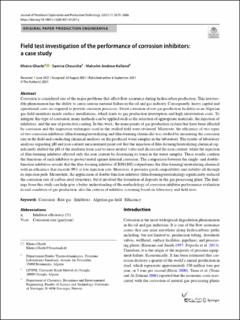| dc.contributor.author | Gharbi, Kheira | |
| dc.contributor.author | Chouicha, Samira | |
| dc.contributor.author | Kelland, Malcolm Andrew | |
| dc.date.accessioned | 2021-10-18T07:25:37Z | |
| dc.date.available | 2021-10-18T07:25:37Z | |
| dc.date.created | 2021-09-20T09:20:07Z | |
| dc.date.issued | 2021-09 | |
| dc.identifier.citation | Gharbi, K., Chouicha, S., Kelland, M.A. (2021) Field test investigation of the performance of corrosion inhibitors: a case study. Journal of Petroleum Exploration and Production Technology, 11. | en_US |
| dc.identifier.issn | 2190-0558 | |
| dc.identifier.uri | https://hdl.handle.net/11250/2823560 | |
| dc.description.abstract | Corrosion is considered one of the major problems that affect flow assurance during hydrocarbon production. This irreversible phenomenon has the ability to cause serious material failure in the oil and gas industry. Consequently, heavy capital and operational costs are required to prevent corrosion processes. Sweet corrosion of raw gas production facilities in an Algerian gas field manifests inside surface installations, which leads to gas production interruption and high intervention costs. To mitigate this type of corrosion, many methods can be applied such as the selection of appropriate materials, the injection of inhibitors, and the use of protective coating. In this work, the main points of gas production system that have been affected by corrosion and the inspection techniques used in the studied field were reviewed. Moreover, the efficiency of two types of two corrosion inhibitors (film-forming/neutralizing and film-forming chemicals) was studied by measuring the corrosion rate in the field and conducting chemical analyses on the produced water samples in the laboratory. The results of laboratory analyses regarding pH and iron content measurement point out that the injection of film-forming/neutralizing chemical significantly shifted the pH of the medium from acid to more neutral value and decreased the iron content, while the injection of film-forming inhibitor affected only the iron content by decreasing its tenor in the water samples. These results confirm the functions of each inhibitor to protect metal against internal corrosion. The comparison between the single- and double-function inhibitors reveals that the film-forming inhibitor (CK981DZ) outperforms the film-forming/ neutralizing chemical with an efficiency that exceeds 99% at low injection rate. Moreover, it provides good compatibility and stability all through its injection path. Meanwhile, the application of double function inhibitor (film-forming/neutralizing) significantly reduced the corrosion rate of carbon steel structures, but it involved the formation of deposits in the gas processing plant. The findings from this study can help give a better understanding of the methodology of corrosion inhibitor performance evaluation in real condition of gas production, also the criteria of inhibitor screening based on laboratory and field tests. | en_US |
| dc.language.iso | eng | en_US |
| dc.publisher | Springer Nature Switzerland AG | en_US |
| dc.rights | Navngivelse 4.0 Internasjonal | * |
| dc.rights.uri | http://creativecommons.org/licenses/by/4.0/deed.no | * |
| dc.subject | corrosion inhibitors | en_US |
| dc.title | Field test investigation of the performance of corrosion inhibitors: a case study | en_US |
| dc.type | Peer reviewed | en_US |
| dc.type | Journal article | en_US |
| dc.description.version | publishedVersion | en_US |
| dc.rights.holder | © The Author(s) 2021 | en_US |
| dc.subject.nsi | VDP::Teknologi: 500::Berg‑ og petroleumsfag: 510::Petroleumsteknologi: 512 | en_US |
| dc.subject.nsi | VDP::Matematikk og Naturvitenskap: 400::Kjemi: 440 | en_US |
| dc.source.pagenumber | 3879–3888 | en_US |
| dc.source.volume | 11 | en_US |
| dc.source.journal | Journal of Petroleum Exploration and Production Technology | en_US |
| dc.identifier.doi | 10.1007/s13202-021-01287-y | |
| dc.identifier.cristin | 1935763 | |
| cristin.ispublished | true | |
| cristin.fulltext | original | |
| cristin.qualitycode | 1 | |

